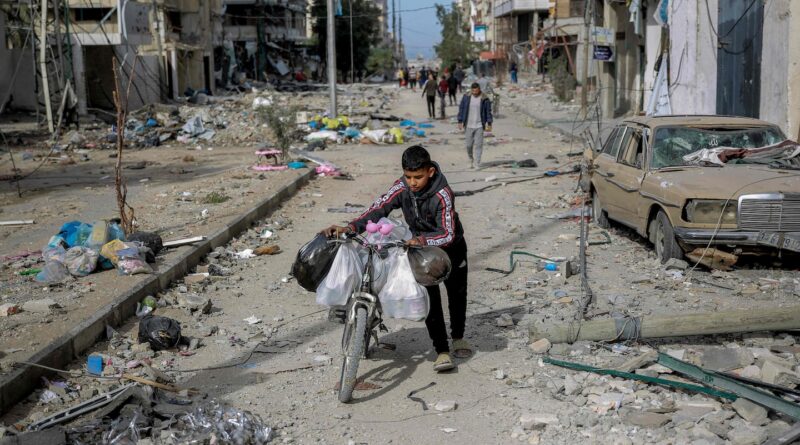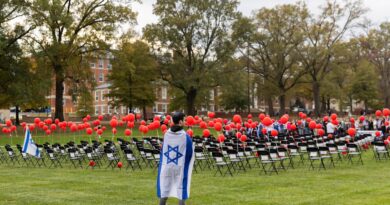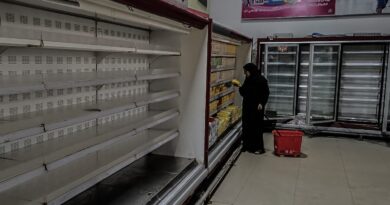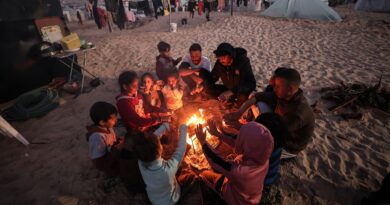Pause brings new perils as Gazans seek family and safety
A father in Gaza City, whom The Washington Post is not identifying because of concern for his safety said he could not make the journey south. He lost his 10-year-old son two weeks ago when a missile struck their kitchen in the Tel al-Hawa neighborhood. He sat with the corpse for four days before it was safe enough to bury the boy outside.
On Saturday, he saw Israeli tanks and a bulldozer from his window and feared for his 14-year-old son and 12-year-old daughter, he said by phone.
“I don’t think it’s safe yet to go outside with the children,” he said. His approach was “to wait and see.”
It might look “as if life returned to normal,” Emad Susi, 49, said by phone from Deir el-Balah, in the central Gaza Strip, having fled Gaza City. “The only thing that has changed is that there are no bombardments. But we have no electricity, struggle to get water, food, medicine and communicate with our beloved family and friends.”
After nearly 50 days of war following a Hamas rampage through southern Israel that left some 1,200 Israelis dead, the pause, part of a deal to exchange captives, has given both sides rare reason to celebrate. But with more than 13,300 people killed in Gaza and at least 35,180 wounded, according to the Gaza Health Ministry, thousands more unaccounted for or missing under the rubble and more war on the horizon, the mood remains bleak.
The fighting has displaced more than 1.7 million people, or about 80 percent of densely populated Gaza, according to the United Nations. Sanitary conditions remain dire, access to food and water is limited and disease is spreading, health officials have warned.
Truckloads of desperately needed aid have begun pouring in. Nearly 200 trucks crossed from Egypt into Gaza on both Friday and Saturday, according to Wael Abu Omar, a spokesperson for the Gaza Crossing Authority. But the increase was still far from the prewar daily average of 500 trucks entering Gaza under restrictions set by Israel, which imposed a land and sea blockade on the coastal enclave after Hamas seized power in 2007.
The pause in fighting has brought new dangers and challenges.
Efforts to dig out loved ones from under rubble have been redoubled. As supplies trickled in, Gazans spent hours in long lines to buy their first fuel in weeks. With communication networks still down or unstable, other civilians made the dangerous trek to check on their homes and relatives — some heading back north despite Israeli warnings not to return.
For some, the return home opened up new wounds.
Ahmed, a father of three, fled his home in Duhour al-deek early in the war and settled in a U.N. storage facility in Rafah, near the Egyptian border. Conditions were so bad, he said, that the wait for a bathroom could take days.
On Thursday night, he said, he and his wife slept in their car to hold a spot in a line for fuel, before driving the once-familiar route to their apartment in a complex, rebuilt with funds from Kuwait after the 2014 war with Israel.
The building was heavily damaged, his apartment door open and his electronics had been stolen, he said. They grabbed some clothes and left.
For those who attempt to return to Gaza’s north, the journey home, forbidden by Israel during the pause, could prove even more perilous. Ahmed said he gave a stranger, bent on checking on his parents at whatever cost, a ride as far north as he dared go. From there, the man set off on foot. Ahmed said he had not heard from him since.
On Saturday, Hamas spokesperson Basem Naim accused Israeli forces of shooting two men dead after they went to check on their homes in Beit Hanoun, in northern Gaza, where Israeli forces remain. Israeli soldiers on Friday shot dead two Palestinians also attempting to return north during the pause, the Associated Press reported.
The Post, which Israel is not permitting to access Gaza independently, could not independently verify the claims.
“The IDF is stationed along the designated operational lines of the pause,” a spokesperson for the Israeli military said in a statement, speaking on the condition of anonymity under Israeli military protocol, without specifying exact areas. “Part of the agreement is that people will not go north.”
Disagreements over the terms of the aid deliveries led to a delay Saturday in the second round of prisoner swaps.
Naim told The Post that among Israel’s alleged violations was that “aid did not reach the north.”
The United Nations and the Palestine Red Crescent said they had delivered and distributed aid in Gaza City and northern Gaza, though some areas remained blocked off by the Israeli military.
On Saturday, a convoy of 59 trucks, most belonging to the Palestine Red Crescent, drove food, water, primary medicines and emergency medical supplies from the south to the north and Gaza City, said Nebal Farsakh, a spokeswoman for the Palestine Red Crescent based in Ramallah. PRCS in a statement called the convoy “the biggest one to bring aid to Gaza and the Northern Governorates” since the war began.
But “paramedics and ambulances are still completely prevented access to many areas,” Farsakh said.
One of those areas, she said, is Gaza City’s Tel al-Hawa neighborhood. For days, families of people stuck in the area have been calling her cellphone and pleading for help, she said.
The father in Tel al-Hawa said he had called the Red Crescent and Red Cross many times but had been told they could not reach him safely.
Asked on Saturday how he was doing, the father replied with a response that has become common in Gaza: “Still living.”
Hazem Balousha in Amman, Jordan, and Sarah Dadouch in Beirut contributed to this report.




